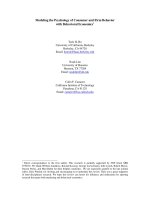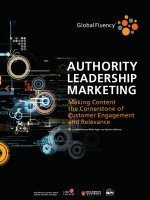Marketing chapter 3a the psychology of sellling
Bạn đang xem bản rút gọn của tài liệu. Xem và tải ngay bản đầy đủ của tài liệu tại đây (608.23 KB, 70 trang )
Go Beyond the Limits!
2.
3.
1.
4.
Start Here
To reach your goals
1
1-1
3
Chapter
The Psychology of Selling:
Why People Buy
McGraw-Hill/Irwin
ABC’s of Selling, 10/e
Copyright © 2009 by The McGraw-Hill Companies, Inc. All rights reserved.
Main Topics
The Tree of Business Life: Benefits
Why People Buy–The Black Box Approach
Psychological Influences on Buying
A FABulous Approach to Buyer Need Satisfaction
How to Determine Important Buying Needs–a Key to Success
The Trial Close–a Great Way to Uncover Needs and SELL
SELL Sequence
Your Buyer’s Perception
3-3
Main Topics, cont...
Perceptions, Attitudes, and Beliefs
The Buyer’s Personality Should Be Considered
Adaptive Selling Based on Buyer’s Style
You Can Classify Buying Situations
Technology Provides Information
Viewing Buyers as Decision Makers
Satisfied Customers Are Easier to Sell to
To Buy or Not To Buy–a Choice Decision
3-4
The Tree of Business Life: Benefits
T
T
T
ce
rvi
Se
Et
hi c
al
T
T
T
T T
T
T
Builds
Guided by The Golden Rule, emphasize
benefits to improve your:
Communication Skills
T
Ability to unselfishly help a person make the
True
correct buying decision
Relationships
T
I
C
3-5
Exhibit 3-1: Why People Buy–
The Black Box Approach
Internalization process is referred to as a
black box.
We cannot see into the buyer’s mind.
Stimulus-response model:
Buyer’s Hidden Mental Process
Sale/No Sale
Sales Presentation
Stimulus
Black box
Response
Exhibit 3-1: Stimulus-response model of buyer behavior
3-6
What’s Known About the
Mental Process
People buy for practical (rational) and psychological (emotional) reasons.
Some of a person’s thoughts can be determined.
Buyers consider certain factors in making purchase decisions.
3-7
Psychological Influences on Buying
Motivation to buy must be there
Needs result from a lack of something desirable
Wants are needs learned by the person
Have practical needs
Have psychological needs
Economic needs: The best value for the money
The buyer’s need to purchase the most satisfying product for the money
3-8
Psychological Influences on Buying, cont…
Awareness of needs: Some buyers are unsure.
Conscious need level –fully known
Preconscious need level – may not be fully aware
Unconscious need level – have needs but do not know what they are
3-9
A FABulous Approach to Buyer
Need Satisfaction
BENEFIT SELLING
3-10
A FABulous Approach to Buyer
Need Satisfaction
Stressing benefits is a very powerful
selling technique
FAB selling technique helps emphasize
benefits
F
A
B
eatures
dvantages
enefits
3-11
The Product’s Features: So What?
Feature – a physical characteristic
Many salespeople emphasize features
Examples:
Size
Color
Price
Shape
3-12
The Product’s Advantages:
Prove It!
Advantage – a performance characteristic
The chances of making a sale are increased by describing the
product’s advantages.
How a product can be used
How a product will help the buyer
Examples:
Fastest-selling
Stores more information
Copies on both sides of the paper
3-13
The Product’s Benefits:
What’s in it for Me?
Benefit – a favorable result of advantage
People are interested in what the product will do for them.
Benefits can be both practical and psychological.
Benefits should be specific statements, not generalizations.
Emphasizing benefits increases sales.
3-14
Why Does Someone Buy These Items?
Diamond ring
Camera film
STP motor oil
Baseball tickets
3-15
People Buy the Product’s Benefits, Such As:
Diamond ring – images of success, investment, to please a loved one
Camera film – memories of places, friends, and family
STP motor oil – engine protection, car investment, or peace of mind
Baseball tickets – entertainment, escape from reality, or relaxation
3-16
People Buy Benefit(s)
Not a product’s feature(s)
Not a product’s advantage(s)
3-17
People Buy Benefit(s)
Notice national television commercials:
They stress benefits.
Advertisers know this helps sell the product.
3-18
People Buy Benefit(s)
High performing salespeople stress benefits.
They know this increases their chances of making the sale and helping
someone.
3-19
What’s In It For Me?
Stressing benefits in the sales presentation answers the prospect’s question,
“What’s in it for me?”
3-20
Can Not Leave Out Features and Advantages
In the sales presentation it is also important to mention features and
advantages.
Here is an example of how to stress a benefit while including a feature and an
advantage:
3-21
Example: Sporting Goods Salesperson to Customer:
“With this ball, you’ll get an extra 10 to 20 yards on your drives (
) helping to reduce your scoreadvantage
(
) because of its new
solid core (
benefit
).”
feature
3-22
FABs Can Be Awkward at First
New salespeople are frequently not accustomed to using feature,
advantage, and benefit phrases.
They may seem awkward at first.
3-23
Use Your FABs
Feature – Physical Characteristic
Buyer thinks “So What?”
Advantage – Performance Characteristic
Buyer thinks “Prove It!”
Benefit – Favorable result from advantage
Benefits are what people buy!
You can also have a benefit of a benefit – a FABB
3-24
Use the FAB Sequence
The standardized FAB Sequence can be used as follows:
The…(feature)…means you…(advantage)…with the real benefit to you
being…(benefit)….
Note how a benefit is emphasized.
Pick a product and insert a FAB of the product into the above
sequence
Put it in your own words
Try it – it works!
3-25









